
You can revisit our #G2great Wakelet Chat Artifact HERE
By Mary Howard
On 6/9/22 our #G2great chat focused on an ever-essential topic of discussion: Creating a Schoolwide Culture of Responsive Kidwatching. Our chat has often emphasized dialogue around formative assessment where kidwatching finds its home such as Re-Examining and Revising Our Thinking To Transform Our Practices: Formative Assessment on 5/6/21 and Formative Assessment and Maximizing Our Potential: Assessment that Informs on 10/11/18. We have discussed kidwatching in many chats, but this week it was the conversational chat star that was worthy of our central focus.
Since we intentionally merged the words RESPONSIVE and KIDWATCHING, let’s take closer look at the word “responsive.” To do this I’ll draw from Larry Ferlazzo’s wonderful interview with Regie Routman shortly after her incredible book was published: Literacy Essentials: Engagement, Excellence, and Equity for All Learners (2018, Stenhouse)
Formative assessment is integral to responsive teaching-in-action, which depends on carefully observing, listening, and supporting students so that students remain engaged, inquisitive, and learn more. That is, in the act of teaching, based on our observations and students’ responses and actions–and in our reflections before and after–we modify, adjust, and revise our teaching to better meet students’ strengths, interests, and needs. Successfully integrating formative assessments into meaningful instruction is often what separates a teacher who struggles from one who can aptly handle any situation. Regie Routman
Responsive Kidwatching illustrates and celebrates the influential impact of professional decision-making and invites us to gather varied in-the-moment observations so that we may engage in “responsive teaching-in-action.” What we learn from students immersed in the learning process offers the informants that will support the choices we make on their behalf as we “modify, adjust, and revise our teaching to better meet students’ strengths, interests, and needs.” In this way, we teach with a lens on students who are squarely at the center of our efforts and acknowledge our responsibility to address their unique needs in meaningful, purposeful and intentional ways. Without our commitment to remain “responsive” to students within the kidwatching process, it will be just one more empty educational term on the battlegrounds of failed efforts.
So, now let’s shift our focus on kidwatching with meaning, purpose and intent.

In each #G2Great chat, we craft six questions around our weekly topic that will guide our discussion. The focus of our six questions this week is shown above. Certainly, each discussion focus is important, but the three highlighted questions are critical entry points. Until we reach agreement about what we mean by kidwatching, have a strong sense of perspective about our role, and can verbalize our central purpose, we are doomed to dishonor the very heart of kidwatching from the onset and reduce it to yet another barely recognizable research-supported practice devoid of value.
KIDWATCHING QUESTION #1: DEFINITION

Our first chat question will determine the very success or failure of kidwatching. How we understand and define kidwatching directly impacts how we approach and ultimately implement Responsive Kidwatching in a way that will reflect intent. What better way to do that than to draw from two experts on the topic, Gretchen Owocki and Yetta Goodman who eloquently define Kidwatching in their influential book, Kidwatching: Documenting Children’s Literacy by (2002, Heinemann)
The primary goal of kidwatching is to support and gain insight into children’s learning by
(1) intensely observing and documenting what they know and can do;
(2) documenting their ways of construction and expressing knowledge; and
(3) planning curriculum and instruction that are tailored to individual strengths and needs. (page x)
Responsive kidwatching is dependent upon all three of these features since they work in support of the kidwatching process. One cannot work in a vacuum as they are complementary. It’s worth emphasizing that we do not engage in kidwatching because it’s the hot topic of the day or required based on a district or program mandate but because we understand what it is and what it looks like in practice so deeply that we are compelled to make it an integral part of every learning day.
#G2Great Chat Twitter Responses to Question #1

KIDWATCHING QUESTION #2: PERSPECTIVE

To honor a strong commitment to kidwatching means putting it into action in the context of teaching and learning and for the purpose of enhancing the choices we make for the sake of student learning. Kidwatching isn’t what is merely scheduled into an obligatory blip on the radar screen of the week if we have time, but a process that we willingly find a place of honor for in each learning day.
When we are dedicated kidwatchers, we observe students while they engage as active participants in the learning process with a curious spirit that drives us to understand who those children are, how they learn and how their identity as a learner and human impacts that learning. This curiosity drives us to know and understand more through close observation, a process Carol Ann Tomlinson aptly refers to as “sleuthing” in So They May Soar: The Principles and Practices of Learner-Centered Classrooms (2021, ASCD)
Consistent, persistent moment-by-moment teacher watchfulness of students as they learn. (p. 150)
What kind of mindset brings this to bear? One of my favorite pages in Kidwatching by Gretchen Owocki and Yetta Goodman is wisely positioned on the first page with a beautiful list of statement about what drives their kidwatching beliefs. Each statement begins with the words: I am the teacher who… Just imagine how we would merge our beliefs about the teaching/learning process and our beliefs about Kidwatching in this way. What would that look like? Why are we doing it? What beliefs drive those efforts? We wondered about that too and so we turned this wondering into the basis of our second question that our chat friends responded to eloquently :
#G2Great Chat Twitter Responses to Question #2
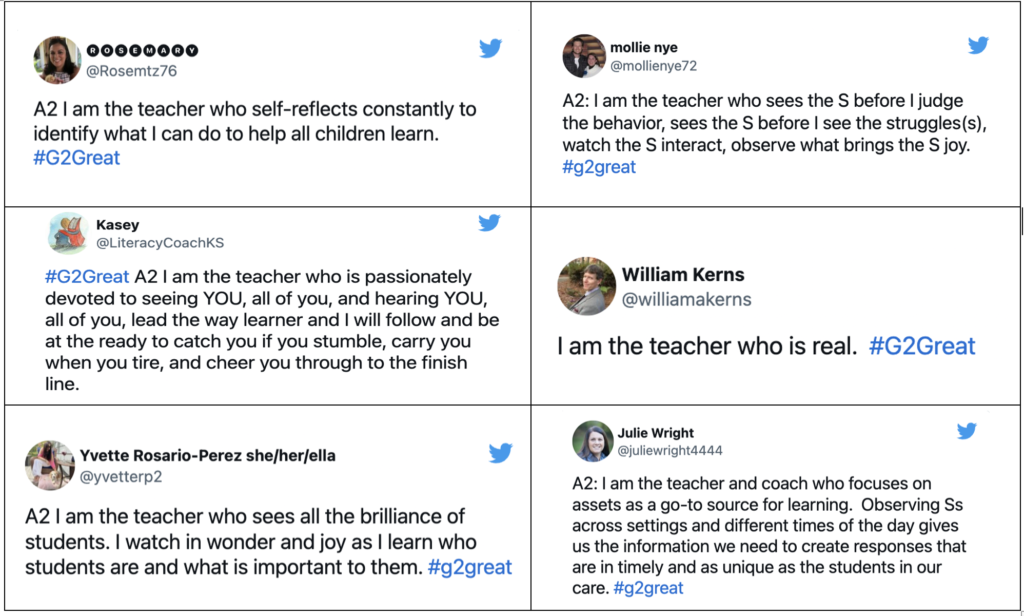
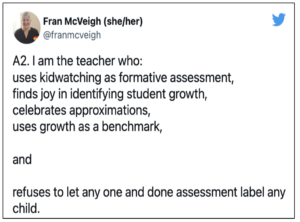
Just imagine what thinking we might not only uncover but discover from a collective perspective if we posed this question based on what each individual brings to the instructional process since kidwatching is an essential part of what we all can and should do:
I am the principal who…
I am the teacher who…
I am the coach who…
I am the support staff who…
I am the interventionist who…
WHAT IF?
KIDWATCHING QUESTION #3: PERSPECTIVE
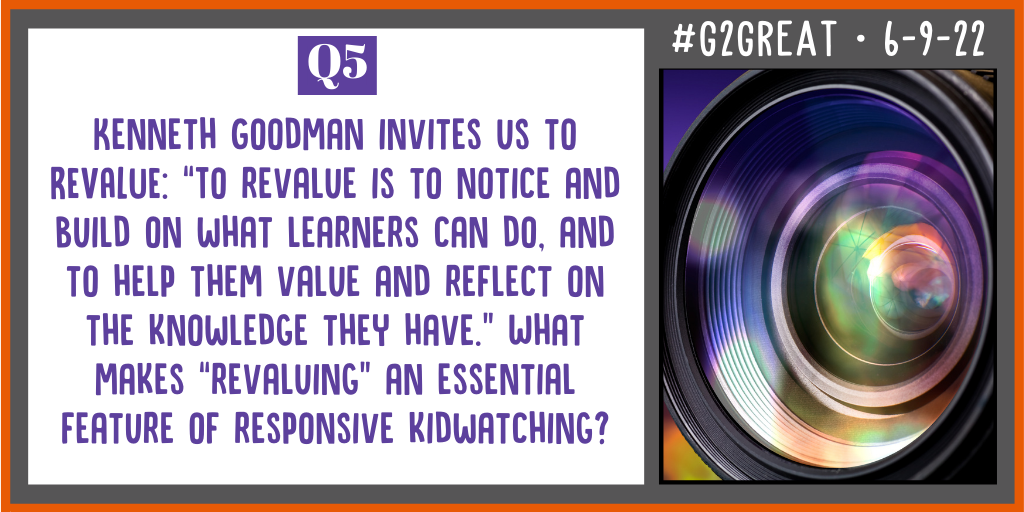
One of my favorite descriptors about kidwatching is from Kenneth Goodman so we used his words in question 3:
“To REVALUE is to notice and build on what learners can do, and to help them value and reflect on the knowledge they have.” Kenneth Goodman
What I particularly love about Kenneth Goodman’s words is the emphasis on focusing on the strengths children bring to the learning process and making them privy to those strengths as a pathway to new learning. The process of REVALUE directly contrasts to the ever present “learning loss” narrative that asks us to focus our attention on what we purport that children are unable to do. In contrast, Goodman asks us to gaze through an appreciative lens to uncover what they are already doing to use that as a stepping stone to next step efforts.
When we capture those noticings, we elevate in the moment observations over time as a reference to support and extend new thinking. Putting kidwatching onto a concrete written tool of our choice allows us to hold on to what we heard, saw and think. This also allows us to look across days at collective noticings where patterns to emerge that impact our professional choices in actionable ways no just on a particular day but across days. This visible reference could also highlight whether what we are focusing our attention on REvaluing or DEvaluing what children bring to the learning experience. We knew that this question was an important part of our chat discussion and our chat friends did not disappoint.
#G2Great Chat Twitter Responses to Question #5
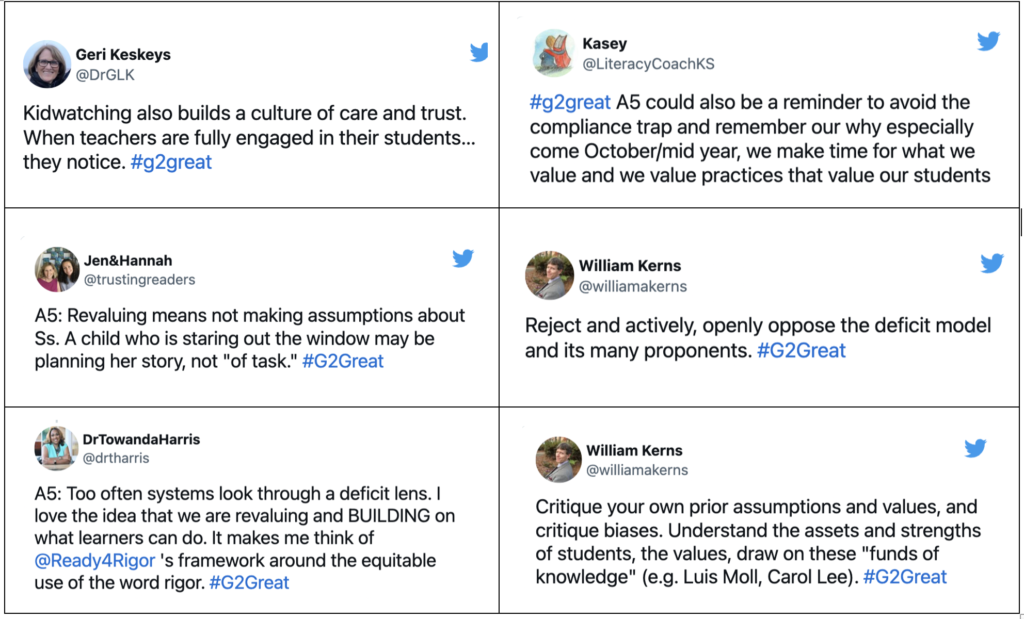
CLOSING THOUGHTS
The practice of responsive kidwatching is more important than ever in an age where we find our schools and questionable publishers that cater to them hyper fixated on that “learning loss” narrative that is far removed from the spirit of kidwatching. Couple this with a never-ending obsession with standardized tests that label children in ways that lead to impersonal directives, and we find ourselves caught in the perfect ‘data storm’. Rigid curriculum and numerical-fueled assessments connected to them have slowly confiscated common sense and de-emphasized up close and personal professional observation as a key informant. Several principals have illustrated a common misconception to me that reflects how kidwatching has been reduced to an irrelevant sacrificial lamb by referring to any form of teacher observation as “opinion.” This ill-informed perspective is a blatant misconception rooted in other-focused directives that ignore the spirit of kidwatching and shamefully disregards the impact of our educators who are committed to research informed understandings.
Our children rely on teachers who bring knowledge to the teaching/learning table over blind faith in numbers without a face. And they rely on us to use RESPONSIVE KIDWATCHING to model our belief in all the wonderful thinking our childrem bring to the learning process. Dedicated kidwatchers believe that the on-the-spot actions of children in the course of each learning day tell us far more than any number on a spreadsheet ever could.
It’s time to make a collective re-commitment to kidwatching and ensure that it’s a visible feature in every classroom in every school. And so I want to close with a wonderful question that Janelle Henderson posed in her incredible post, Will the Real Data Please Stand UP:
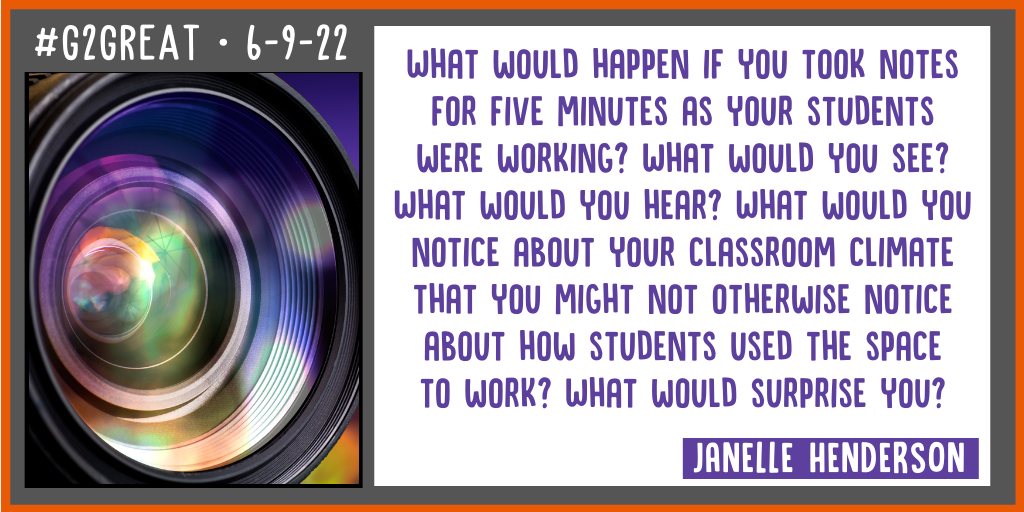
Just imagine the collective commitment to kidwatching this would invite!
LINKS
Kidwatching: Documenting Children’s Literacy by Gretchen Owocki and Yetta Goodman (2002, Heinemann)
Kidwatching 2.0: Top 3 Moves for Real-time Assessment to Meet Every Student’s Needs by Julie Wright (Corwin)
Will the Real Data Please Stand UP by Janelle Henderson (Heinemann)
Maximizing Our Potential (part 5): Assessment that Informs by Mary Howard
Re-Examining and Revising Our Thinking To Transform Our Practices: Formative Assessment by Brent Gilson